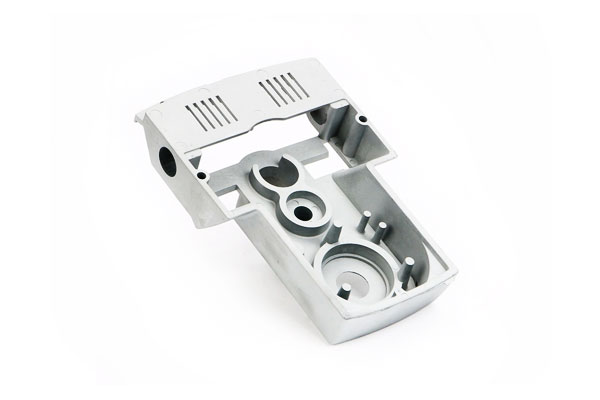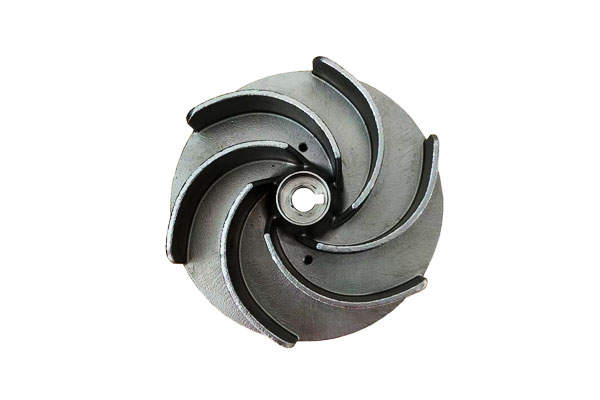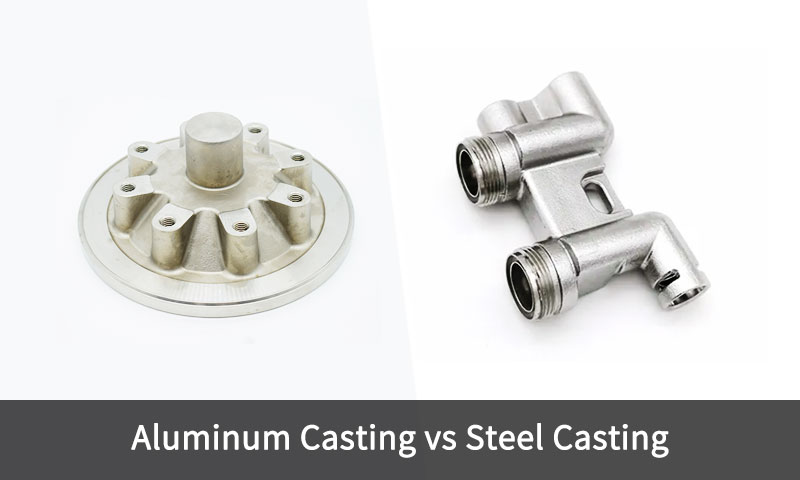1. Introduzione
Aluminum vs Steel Casting — choosing between these two foundational materials shapes component performance, cost and manufacturability across industries from automotive to energy.
This comparison is not merely about metal chemistry: it encompasses density and stiffness, comportamento termico, casting process compatibility, secondary processing (Trattamento termico, Ingegneria di superficie), lifecycle cost and application-specific reliability.
Engineers and purchasers must therefore evaluate the entire system—loading, temperatura, environment, production volume and finish requirements—before specifying a metal and casting route.
2. Fundamental Material Differences Between Aluminum vs Steel
At the core of aluminum vs. steel casting lies a fundamental metallurgical and physical contrast that directly affects how each material behaves during casting, lavorazione, e servizio.
| Proprietà | Alluminio (PER ESEMPIO., Al-Si alloys) | Acciaio (PER ESEMPIO., carbon or low-alloy steels) | Implicazioni ingegneristiche |
| Densità (g/cm³) | 2.70 | 7.85 | Aluminum is ~65% lighter, offering major weight savings for transportation and aerospace. |
| Punto di fusione (° C.) | 615–660 | 1425–1540 | Aluminum’s low melting point enables easier casting and lower energy consumption; steel requires specialized furnaces. |
| Conducibilità termica (W/m · k) | 120–180 | 40–60 | Aluminum dissipates heat efficiently—ideal for engines, scambiatori di calore, ed elettronica. |
| Forza specifica (MPa/ρ) | ~100–150 | ~70–90 | Despite lower absolute strength, aluminum’s strength-to-weight ratio surpasses that of steel. |
| Modulo elastico (GPA) | 70 | 200 | Steel is stiffer, providing better rigidity under load and vibration. |
Resistenza alla corrosione |
Eccellente (forms Al₂O₃ layer) | Variabile; prone to rust without coatings | Aluminum resists oxidation naturally, while steel needs surface protection (pittura, placcatura, or alloying with Cr/Ni). |
| Machinabilità | Eccellente | Moderate to difficult | Aluminum’s softness allows easy machining and shorter cycle times; steel requires tougher tooling. |
| Riciclabalità | >90% recoverable | >90% recoverable | Both materials are highly recyclable, though aluminum’s remelting requires less energy (5% of primary production). |
| Casting Shrinkage (%) | 1.3–1.6 | 2.0–2.6 | Steel shrinks more during solidification, demanding larger allowances and more complex gating/feeding systems. |
| Costo (ca., USD/kg) | 2.0–3.0 | 0.8–1.5 | Aluminum is more expensive per kilogram, but savings in weight and processing can offset total lifecycle costs. |
3. What Is Aluminum Casting?
Alluminio casting is the process of shaping molten aluminum or aluminum alloys into complex, near-net-shape components using molds.
It is one of the most widely used metal casting processes globally—accounting for over 50% of all nonferrous castings—due to aluminum’s excellent castability, bassa densità, e resistenza alla corrosione.

Panoramica
In aluminum casting, alluminio fuso (in genere tra 680–750°C) is poured or injected into a mold cavity where it solidifies into the desired geometry.
Aluminum’s low melting point and high fluidity make it ideal for both mass-production methods (like die casting) E Applicazioni ad alta precisione (like investment casting).
Key Features of Aluminum Casting
- Rapporto leggero e alto resistenza:
Aluminum castings offer excellent mechanical performance while being about Un terzo del peso dell'acciaio. - Buona resistenza alla corrosione:
Un sottile, auto-guarigione strato di ossido di alluminio (Al₂o₃) protects against oxidation and most atmospheric or marine corrosion. - Eccellente conduttività termica ed elettrica:
Suitable for applications like scambiatori di calore, Alloggi, and electric components. - Riciclabalità:
Aluminum can be recycled indefinitely without degradation, reducing production energy by up to 95% compared to primary smelting.
Common Aluminum Casting Processes
| Metodo di casting | Descrizione | Applicazioni tipiche |
| Pressofusione | High-pressure injection of molten aluminum into steel dies; yields precise, parti a parete sottile. | Parti automobilistiche (Alloggiamenti degli ingranaggi, parentesi), Elettronica di consumo. |
| Casting di sabbia | Molten metal poured into sand molds; suitable for larger, lower-volume parts. | Blocchi del motore, collettori, custodie aerospaziali. |
| Colata di investimento | Ceramic molds from wax patterns; ideal for fine details and tight tolerances. | Componenti a turbina aerospaziale, dispositivi medici. |
| Casting per stampo permanente | Reusable metal molds; good surface finish and dimensional control. | Pistoni, ruote, e componenti marini. |
| Casting centrifugo | Uses centrifugal force to distribute molten metal; denso, Struttura senza difetti. | Tubes, maniche, and rings. |
Vantaggi del casting in alluminio
- Leggero: Reduces component weight by 30–50% vs. acciaio, Migliorare l'efficienza del carburante (automobile) or payload capacity (aerospaziale).
- Efficienza energetica: Melting aluminum requires 60–70% less energy than steel (570° C vs. 1420° C.), lowering processing costs by 20–30%.
- Resistenza alla corrosione: Eliminates the need for coatings (PER ESEMPIO., colore, zincatura) nella maggior parte degli ambienti, reducing maintenance costs by 40–50%.
- High-Volume Viability: Die casting enables production of 1000+ parts/day per machine, meeting consumer goods demand.
Disadvantages of Aluminum Casting
- Resistenza inferiore: Resistenza alla trazione (150–400 MPA) is 50–70% lower than high-strength steel, limiting use in heavy-load applications.
- Poor High-Temperature Performance: Retains only 50% of room-temperature strength at 250°C, making it unsuitable for engine exhaust or power plant components.
- Rischio di porosità: Die-cast aluminum is prone to gas porosity (from high-pressure injection), restricting heat treatment options (PER ESEMPIO., T6 temper requires vacuum processing).
- Higher Raw Material Cost: Primary aluminum costs $2,500–$3,500/tonne, 2–3x more than carbon steel.
Industrial Applications of Aluminum Casting
Aluminum casting is widely used across multiple industries due to its combination of design leggero, machinabilità, e resistenza alla corrosione:
- Automobilistico: Blocchi del motore, Cali di trasmissione, ruote, and suspension arms.
- Aerospaziale: Parentesi, raccordi strutturali, Alloggiamenti del compressore.
- Elettronica: Dissipatori di calore, Alloggi a motore, recinti.
- Beni di consumo: Elettrodomestici, utensili elettrici, hardware di mobili.
- Marine and Renewable Energy: Eliche, Alloggi, e lame di turbina.
4. What Is Steel Casting?
Steel casting is the process of pouring molten steel into a mold to produce complex, high-strength components that cannot be easily fabricated or forged.
Unlike aluminum, steel has a punto di fusione più elevato (≈ 1450–1530°C) and greater tensile strength, rendendolo ideale per load-bearing and high-temperature applications such as machinery, infrastructure, e generazione di energia.

Panoramica
In steel casting, carefully alloyed molten steel is poured into either expendable (sabbia, investimento) or permanent molds, where it solidifies into a shape close to the final part.
Because steel shrinks significantly upon cooling, precise temperature control, Design gating, and solidification modeling sono critici.
Steel castings are known for their robustezza meccanica, Resistenza all'ambiente, e integrità strutturale, particularly under harsh service conditions.
Key Features of Steel Casting
- Exceptional Strength and Toughness:
Yield strengths often exceed 350 MPA, with heat-treated alloys reaching over 1000 MPA. - High-Temperature Capability:
Retains strength and oxidation resistance up to 600–800°C, depending on composition. - Versatile Alloy Selection:
Includes Acciadi di carbonio, acciai a basso livello, acciai inossidabile, and high-manganese steels, each tailored for specific environments. - Saldabilità e macchinabilità:
Cast steels can be post-processed effectively—machined, saldato, and heat-treated to enhance performance.
Common Steel Casting Processes
| Metodo di casting | Descrizione | Applicazioni tipiche |
| Casting di sabbia | Molten steel poured into bonded sand molds; Ideale per grandi, parti complesse. | Corpi valvole, involucri di pompaggio, machinery housings. |
| Colata di investimento | Ceramic molds formed from wax patterns; yields excellent accuracy and surface finish. | Lame di turbina, Strumenti chirurgici, parti aerospaziali. |
| Casting centrifugo | Rotational force distributes molten steel evenly; produces dense cylindrical components. | Tubi, rivestimenti, portando razze. |
| Casting per stampo a conchiglia | Uses thin resin-coated sand molds; allows higher precision and smoother surfaces. | Piccole parti del motore, parentesi. |
| Casting continuo | For semi-finished steel products like slabs and billets. | Raw material for rolling and forging. |
Advantages of Steel Casting
- Forza superiore & Tenacità: Resistenza alla trazione (fino a 1500 MPA) e la tenacità dell'impatto (40–100 J) make it irreplaceable for structural safety (PER ESEMPIO., componenti del ponte, telaio automobilistico).
- Prestazioni ad alta temperatura: Operates reliably at 400–600 ° C. (vs. aluminum’s 250°C limit), suitable for jet engine casings and power plant boilers.
- Low Raw Material Cost: Carbon steel costs $800–$1200/tonne, 60–70% less than primary aluminum.
- Resistenza all'usura: Heat-treated steel (PER ESEMPIO., 4140) has surface hardness up to 500 Hb, reducing replacement frequency in abrasive applications by 50–70%.
Disadvantages of Steel Casting
- High Weight: Density 2.7x that of aluminum increases fuel consumption (automobile) or structural load (edifici).
- High Energy Use: Melting steel requires 25–30 MWh/tonne (vs. 5–7 MWh/tonne for aluminum), increasing processing costs by 40–50%.
- Suscettibilità alla corrosione: Carbon steel rusts in moist environments (tasso di corrosione: 0.5–1,0 mm/anno in salt spray), requiring coatings (PER ESEMPIO., zincatura) that add $1.5–$2.5/kg to costs.
- Poor Machinability: Hardness requires specialized tools, Aumentare il tempo di lavorazione di 30–50% vs. alluminio.
Industrial Applications of Steel Casting
Steel castings dominate industries demanding forza, durabilità, e resistenza al calore:
- Costruzione & Mining: Excavator teeth, parti di frantumista, track links.
- Energia & Generazione di energia: Steam turbine casings, corpi valvole, componenti nucleari.
- Olio & Gas: Drill heads, pipeline valves, collettori.
- Trasporto: Train couplers, Alloggiamenti degli ingranaggi, heavy-duty engine blocks.
- Aerospaziale & Difesa: Attrezzatura di atterraggio, raccordi strutturali, armor components.
5. Confronto completo: Fusione di alluminio vs acciaio
Process fit and part geometry
- A parete sottile, complesso, Parti ad alto volume: aluminum die casting is optimal (HPDC).
- Grande, pesante, load-bearing parts: steel/spheroidal graphite (Duchi) iron and cast steels via sand casting are preferred.
- Medium volume with high integrity requirements: low-pressure aluminum or investment casting steels depending on strength needs.
Mechanical performance & post-elaborazione
- Trattamento termico: cast steel can be quenched & tempered to obtain high strength and toughness; aluminum alloys have age-hardening routes but reach lower maximum strengths.
- Surface engineering: aluminum readily anodizes; steel can be nitrided, carburized, induction hardened or coated with hard substances (ceramica, Cromo duro).
Autisti di costo (typical considerations)
- Material cost per kg: aluminum raw metal tends to be priced higher per kg than ferrous scrap/steel, but part mass reduces required amount.
- Utensili: die casting dies are expensive (high initial amortization) but low per-part cost at volumes >10k–100k; sand tooling is cheap but per-part labor higher.
- Lavorazione: aluminum machines faster (higher removal rates), lower tool wear; steel requires harder tooling and more machining time—raises total cost especially for small batches.
Produzione & defect modes
- Porosità: HPDC aluminum can develop gas and shrinkage porosity; permanent-mold and low-pressure reduce porosity.
Steel castings can suffer inclusions and segregation; controlled melting and post-HT reduce defects. - Controllo dimensionale: die cast aluminum attains tight tolerances (± 0,1-0,3 mm); sand cast steel tolerances are looser (±0.5–2 mm) without post-machining.
Ambientale & life-cycle
- Riciclaggio: both metals are highly recyclable. Recycled aluminum uses a small fraction (~5–10%) of the energy of primary smelting; recycled steel also has large energy savings compared to virgin iron.
- Use-phase: lightweight aluminum can reduce fuel consumption in vehicles — a system-level environmental benefit.
Tavolo: Aluminum vs Steel Casting — Key Technical Comparison
| Categoria | Casting in alluminio | Casting d'acciaio |
| Densità (g/cm³) | ~2.70 | ~7.80 |
| Punto di fusione (° C. / ° f) | 660° C. / 1220° f | 1450–1530°C / 2640–2790°F |
| Forza (Trazione / Prodotto, MPA) | 130–350 / 70–250 (as-cast); fino a 500 Dopo il trattamento termico | 400–1200 / 250–1000 (A seconda del trattamento e del trattamento termico) |
| Durezza (Hb) | 30–120 | 120–400 |
| Modulo elastico (GPA) | 70 | 200 |
| Conducibilità termica (W/m · k) | 150–230 | 25–60 |
| Conducibilità elettrica (% IACS) | 35–60 | 3–10 |
| Resistenza alla corrosione | Eccellente (strato di ossido naturale) | Variable — requires alloying (Cr, In, Mo) o rivestimento |
| Resistenza all'ossidazione (High-Temp) | Limitato (<250° C.) | Buono a eccellente (up to 800°C for some alloys) |
| Machinabilità | Eccellente (morbido, easy to cut) | Da moderato a povero (Più forte, abrasivo) |
| Castabilità (Fluidità & Restringimento) | Elevata fluidità, basso restringimento | Lower fluidity, higher shrinkage — needs precise gating |
| Vantaggio del peso | ~65% lighter than steel | Heavy — suitable for structural loads |
Finitura superficiale |
Liscio, good detail reproduction | Rougher surfaces; may need machining or shot blasting |
| Heat Treatment Flexibility | Eccellente (T6, T7 tempers) | Ampio (ricottura, spegnimento, tempra, normalizzare) |
| Riciclabalità | >90% recycled efficiently | >90% recyclable but requires higher remelting energy |
| Production Cost | Lower energy, tempi di ciclo più veloci | Higher melting cost and tool wear |
| Tolleranze tipiche (mm) | ±0.25 to ±0.5 (morire casting); ±1.0 (Casting di sabbia) | ±0.5–1.5 depending on process |
| Environmental Footprint | Basso (especially recycled aluminum) | Higher CO₂ and energy footprint due to high melting point |
| Applicazioni tipiche | Ruote automobilistiche, Alloggi, parti aerospaziali, beni di consumo | Valvole, turbine, macchinari pesanti, componenti strutturali |
6. Conclusione
Aluminum and steel castings solve different engineering problems.
Aluminum excels where peso leggero, conducibilità termica, surface quality and high production rates matter.
Acciaio (and cast irons) dominate where alta resistenza, rigidità, resistenza all'usura, toughness and elevated temperature performance sono richiesti.
Good material selection balances functional requirements, costo (total life cycle), producibility and finishing.
In many modern designs hybrid solutions appear (steel inserts in aluminum castings, clad or bimetallic components) to exploit the strengths of both metals.
FAQ
Che è più forte: cast aluminum or cast steel?
Cast steel is significantly stronger—A216 WCB steel has a tensile strength of 485 MPA, 67% higher than A356-T6 aluminum (290 MPA).
Steel also has far greater toughness and wear resistance.
Can cast aluminum replace cast steel?
Only in applications where weight reduction is prioritized over strength (PER ESEMPIO., automotive non-structural parts).
Steel is irreplaceable for high-load, high-temperature components (PER ESEMPIO., involucri di turbine).
Which is more corrosion-resistant: cast aluminum or cast steel?
Cast aluminum is more corrosion-resistant in most environments (tasso di corrosione <0.1 mm/anno) vs. acciaio al carbonio (0.5–1,0 mm/anno).
Stainless steel castings match aluminum’s corrosion resistance but cost 2–3x more.
Which casting process is best for aluminum vs. acciaio?
Aluminum is ideal for die casting (alto volume) and sand casting (basso costo).
Steel is best for sand casting (Grande parti) e casting di investimenti (complesso, high-tolerance components). Die casting is rarely used for steel.


